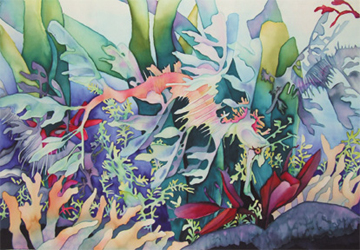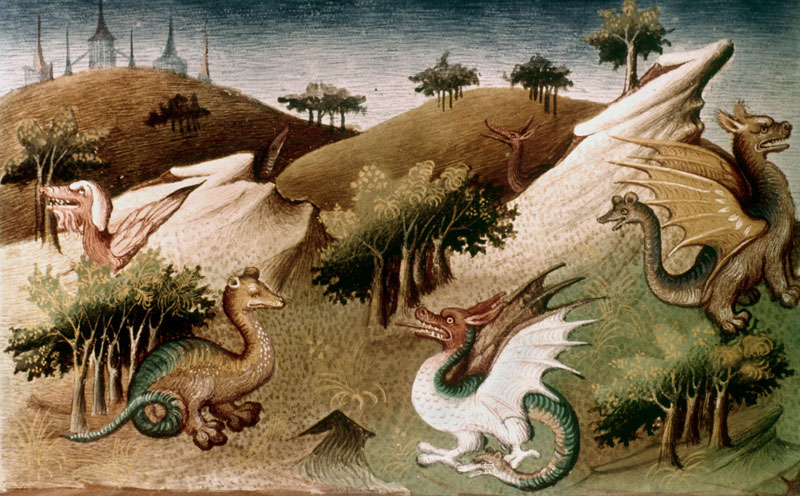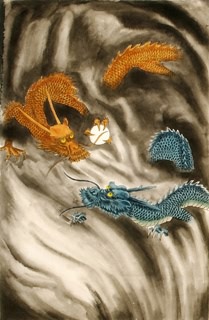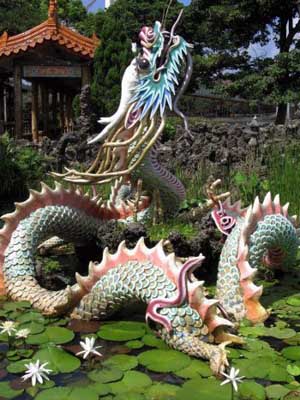Chinese Dragon Art Biography
Source(google.com.pk)
The earliest Chinese dragon depictions discovered so far date back some 7000 years. An ancient Yangshao burial site found in the 1980s in Henan Province showed an adult male skeleton lying between images of a dragon and a tiger made with clamshells. Ancient dragon imagery has also been found on clay pots and jewellery at many sites in China. There are only theories as to where dragon images came from but dinosaur bones were being dug up in ancient China and are referred to in documents from the time as ‘dragon bones’ and were often used in medicine. However, dragons may only be the artistic interpretations of wild animals – crocodiles and snakes. Although their source is still unknown for certain, dragons were common in Chinese mythology and legend.
In Chinese culture, dragons are commonly associated with water in all its forms: rainfall, snow, clouds, storms and oceans. Because the weather was very important to farming and fishing, dragons were respected and even worshipped. They becomes symbols of strength and power and so many emperors adopted dragon imagery to show off their might and superiority. Dragons adorned clothing, buildings, furniture, walls, flags, paintings and were considered sacred.
Depictions of dragons tend to follow certain rules. They are usually shown as serpentine creatures with four limbs, each limb having three to five talons or claws. There was a time when the four and five clawed dragons were used only by senior figures in the palaces while the three clawed dragon was permitted to be used by common citizens. It was even considered treason during the Ming Dynasty to use a five-clawed golden dragon image, which was permitted for use only by the Emperor.
The dragon traditionally has 117 scales comprising 81 yang and 36 yin (9×9 and 9×4). The number nine is frequently associated with dragons – nine being the highest single digit number. Nine represents the sky in the I Ching (Book of Changes) and dragons are often shown in groups of nine. Chen Rong was a painter in 13th century China and was most famous for his images of dragons. Perhaps his most recognised work is a handscroll, ‘The Nine Dragons’, which shows nine dragons all in their natural element. The ‘Nine Dragon Wall’ is a large screen decorated with nine relief sculptures of dragons that can be found at many historical sites in China such as the Forbidden City in Beijing and Pingyao theatre in the city of Pingyao. Some of these elaborate walls date back to the late 14th century, during the Ming Dynasty.
The dragon is sometimes shown holding a flaming orb. This may represent the sun, as many Chinese people believe dragons have a mythical connection with the sun. However many sources refer to it as a pearl. The pearl is a symbol of good fortune and is often a feature of dragon designs. It also resembles a miniature moon, and the moon has links to water, particularly tides, which ties in with the dragon’s connection with the sea. The Chinese dragon image is now quite familiar in the West. Although the spiritual and cultural meanings of the dragon are sometimes lost, it is universally recognised as a symbol of China and the East. It is often used in branding and marketing food products that claim to be authentic. It is also used frequently in the Chinese tourism industry. Basically, the dragon image is used wherever possible to help sell any product or service that has any link to China, as if it were some kind of seal of authenticity. In some ways the Chinese dragon has become what you might call a gimmick.
The iconic dragon image might be loosing it’s meaning the way many symbols do, but the fact is that it’s visually appealing, and the depiction of a golden dragon still sparks the imagination, inside and outside China.
Chinese Dragon Art Chinese Dragon Tattoo Head Dance Symbol Drawing Pictures Parade Costume Mask Images

Chinese Dragon Art Chinese Dragon Tattoo Head Dance Symbol Drawing Pictures Parade Costume Mask Images

Chinese Dragon Art Chinese Dragon Tattoo Head Dance Symbol Drawing Pictures Parade Costume Mask Images

Chinese Dragon Art Chinese Dragon Tattoo Head Dance Symbol Drawing Pictures Parade Costume Mask Images

Chinese Dragon Art Chinese Dragon Tattoo Head Dance Symbol Drawing Pictures Parade Costume Mask Images

Chinese Dragon Art Chinese Dragon Tattoo Head Dance Symbol Drawing Pictures Parade Costume Mask Images

Chinese Dragon Art Chinese Dragon Tattoo Head Dance Symbol Drawing Pictures Parade Costume Mask Images

Chinese Dragon Art Chinese Dragon Tattoo Head Dance Symbol Drawing Pictures Parade Costume Mask Images

Chinese Dragon Art Chinese Dragon Tattoo Head Dance Symbol Drawing Pictures Parade Costume Mask Images

Chinese Dragon Art Chinese Dragon Tattoo Head Dance Symbol Drawing Pictures Parade Costume Mask Images

Chinese Dragon Art Chinese Dragon Tattoo Head Dance Symbol Drawing Pictures Parade Costume Mask Images
No comments:
Post a Comment